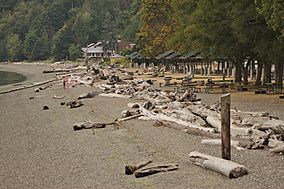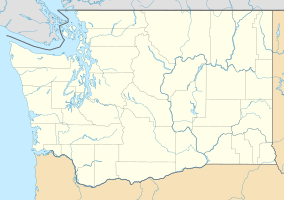Kayak Point County Park facts for kids
Quick facts for kids Kayak Point County Park |
|
|---|---|

The beach at Kayak Point County Park, pictured in 2017
|
|
| Location | Snohomish County, Washington, U.S. |
| Area | 670 acres (270 ha) |
| Elevation | 3 ft (0.9 m) |
| Established | 1972 |
| Governing body | Snohomish County Parks and Recreation |
| Website | Kayak Point Regional County Park |
Kayak Point County Park is a popular park located near Warm Beach in Snohomish County, Washington. This large park covers about 670 acres (270 ha) of land. It sits right along Port Susan, offering a beautiful saltwater beach.
The park is a great spot for outdoor fun. It has a place to launch boats, a disc golf course, and public campgrounds. Many people visit Kayak Point for activities like fishing, crabbing, and birdwatching. It's actually the most visited county park in Snohomish County!
Kayak Point was once a private seaside resort from the 1920s to the 1950s. It got its name from two Inuit kayaks brought there from Alaska. Later, in the 1960s, a big company wanted to build an oil refinery here. But local residents strongly disagreed. They fought against the plan, and eventually, the company decided not to build the refinery. The county then bought the waterfront land and created the park in 1972.
Contents
Park History: From Resort to Park
The Kayak Point area was originally the home of the Snohomish people. American loggers started settling here in the mid-1800s. After most of the trees were cut down, a real estate developer from Seattle bought a huge amount of land.
Early Days and the Kayak Point Resort
This developer, Clarence Dayton Hillman, bought about 12,000 acres (4,900 ha) of land between 1907 and 1909. He divided the land into smaller pieces and called the area "Birmingham." He sold these 5-acre (2.0 ha) plots of land to people.
Later, in the 1920s, the Kilian family built a seaside resort on their property. They added roads, cabins, and a place to launch boats. They named their resort "Kayak Point." This name came from two Inuit kayaks that were brought from King Island, Alaska. These kayaks were displayed right in front of the resort's store.
Plans for an Oil Refinery
In the late 1950s, the Atlantic Richfield Company bought the resort and the land around it. Their big idea was to build an oil refinery there. For a while, the resort kept running, leased out to a businessman.
In 1967, Atlantic Richfield officially announced their plan for a huge 2,200-acre (890 ha) oil refinery. They wanted the county to change the rules for the land so they could build it. Kayak Point seemed like a good spot because it had deep water, good road access, and workers nearby. The company also planned to bring crude oil from Canada by pipeline. This refinery would have cost a lot of money and created many jobs.
Local Opposition to the Refinery
However, local residents were very upset about the refinery plans. They formed a group called the Save Port Susan Committee. They spoke out against the plans at a public meeting in November 1967. Even with their concerns, the county planning commission and commissioners approved the change to allow the refinery.
As part of the deal, Atlantic Richfield agreed to set aside 240 acres (97 ha) for public recreation. They also promised to clean up any oil spills. But people were still worried about pollution and more industrial development.
The Save Port Susan Bay Committee took legal action against the county. They wanted the decision to be reversed. In October 1968, Atlantic Richfield announced they would drop their plans for the Kayak Point refinery. They decided to build a refinery somewhere else because of the delays caused by the legal challenges.
Even after the company pulled out, the committee continued their legal fight. They wanted the land to go back to being for homes, not industry. A judge ruled that the county's decision was unfair to local residents. The case went all the way to the Washington Supreme Court. The court agreed that the county's decision was not in the best interest of the area and was therefore invalid.
Later Development Plans
Atlantic Richfield still owned about 1,200 acres (490 ha) of land at Kayak Point. In the early 1970s, they started planning a large community with homes for nearly 15,000 people. But this plan depended on improving the roads nearby.
In 1979, the county planning commission said no to the first part of the development. They said the local roads and sewer systems were not good enough. After this rejection, Atlantic Richfield gave up on their plans for Kayak Point. They left their land undeveloped.
Creating Kayak Point County Park
The Snohomish County government started buying waterfront land near Kayak Point in 1968. Their goal was to create the county's first saltwater park. After Atlantic Richfield decided not to build the oil refinery, the county began talking about buying the company's waterfront property.
In 1972, the county bought 670 acres (270 ha) from Atlantic Richfield for $1.4 million. They used money from federal and state funds. Atlantic Richfield also donated $250,000 to help develop the park. Kayak Point County Park was officially opened in 1976. The former resort owner, Art Kilian, was there for the dedication.
The county is now planning future updates for Kayak Point County Park. They want to add more camping areas, a community center, and exhibits about the environment. They might also add new camping yurts, cabins, and a ranger station.
Park Features and Fun Activities
Kayak Point is a special place with a sandy beach that formed from the erosion of nearby cliffs. Most of the 660-acre (270 ha) park is still natural. Only about 40 acres (16 ha) are used for recreation.
The park has a 3,300-foot-long (1,000 m) sandy beach along Port Susan. You'll find picnic shelters and parking near the beach. A boat launch and a 300-foot-long (90 m) pier break up the beach area. Next to the beach and pier, there's an open field with bigger shelters and a playground.
For those who want to stay longer, the park offers overnight campsites, yurts, and cabins for rent. Kayak Point is the most popular park in the county. It's a great place for many activities, including fishing, crabbing, windsurfing, hiking, and birdwatching.
East of the park, there used to be an 18-hole public golf course. It covered 250 acres (100 ha) of the park's land. The golf course opened in 1977 but closed in October 2018. It was replaced by a disc golf course, which opened in February 2020.



